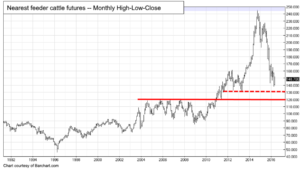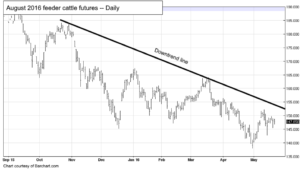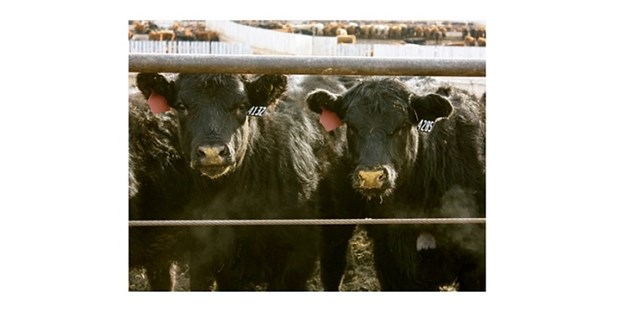By John DePutter & Dave Milne, DePutter Publishing Ltd.
Last posting, we took a look at downside objectives for live cattle futures; this week let’s look at feeder cattle futures.
First, a refresher on our previous post. It concluded the worst was over for live cattle futures, at least for the time being. Several deferred contracts had plunged to the US$112/cwt area, seemingly low enough to account for a lot of bearish developments.
Now, how about the bear market for feeders? It’s been just about as severe as the bear for live futures. From the record-high peak in 2014 of about $240, nearby feeder futures recently notched trades below $140.
That $100 break represented more than the total value of feeder cattle on lots of occasions as recently as 2000 through to 2010.
This is a commodity that lost more than 40% of its value in less than 18 months!
After such a massive loss, you have to think the market is ready for a bounce. It has taken a small bounce in the past few weeks but so small it hardly registers on the 25-year picture below.
One area of chart support sits at roughly $133, the approximate lows seen in 2012 and 2013 (as shown by the dashed line below).
If the current bounce fails soon and the market takes another step down, that’s where you can expect prices to head.
A second support zone, a more significant one, rests at $120. But we’re skeptical nearby futures will get that low the next few months during the current down move.

There’s also a chance the low is already in place. However, as the daily chart of August feeders shows, the market has not yet broken its primary downtrend line. The recent rally could be merely another correction before another leg down.

The fate of feeders lies partly in the hands of the finished cattle and corn markets. For its part, the corn market is more buoyant than during winter, showing moderate strength, which is normal for this time of year. If the US crop looks good in June and July and corn prices are under US$4/bu, feeders might find some support. If the US crop runs into trouble and corn futures move up toward $4.50/bu or higher, feeder cattle buyers will obviously be wanting to pay less for their placements.
Standing back and taking a look at the beef and total meat supply in the US, we see there’s lots of it. This basic fundamental factor doesn’t say much about exactly where the bear market for feeders will bottom (or where live prices will bottom) but it does suggest the markets are not without downside risk. It also hints whatever rallies get going will not be nearly as powerful as in 2014.
In its monthly supply-demand report May 10, the USDA projected total red meat and poultry production for 2016 at 97.22 billion pounds, up 3.1% from 94.28 in 2015. Red meat output was projected at 50.12 billion pounds, up 3.2% from 48.52 in 2015. Beef production was forecast at 24.87 billion pounds, up 4.6% from 23.76 the previous year.
Weekly beef production more recently has been up sharply from a year ago, supporting the projections for generally rising beef supplies.
What’s more, initial projections for 2017 are for more increases.
It’s hard to say how much of the supply increase is already built into the downtrodden live cattle futures markets and by extension, feeder futures.
At least some is, as futures are trading at discounts to cash. At press time, the cash feeder cattle index sits a little above US$150. The Aug future is under $144, Oct is a lot lower at $140 and Jan 2017 is lower yet, at just $132. Farther out, March and April 2017 are in the $128-129 area.
So the futures market is reflecting expectations of a weaker feeder market out into the spring of 2017.
In conclusion:
- The long-term 25-year futures chart depicts a crashing bear market that could be getting close to an important low. If a low has not already come into place, look for support for the feeder cattle index and nearby futures in the $130-135 area.
- For its part, the shorter-term chart of Aug futures shows a bottoming attempt but no clear, lasting bottom yet.
- The basic underlying fundamental factor of rising US production allows for lower prices over time, and tells us another bull market anywhere close to the one of 2014 is NOT around the corner.
Brought to you in partnership by:



